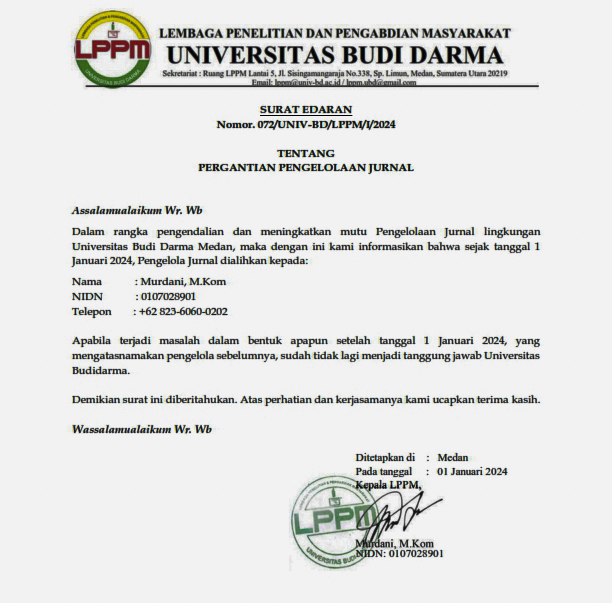Klasifikasi Citra Daging Sapi dan Daging Babi Menggunakan CNN Arsitektur EfficientNet-B6 dan Augmentasi Data
DOI:
https://doi.org/10.30865/json.v4i4.6195Keywords:
Augmentation, CNNs, Meat, Deep Learning, ClassificationAbstract
In daily life, beef often serves as a staple food for humans. However, the high and expensive price of beef has prompted traders to adulterate it with pork for the sake of profit. Such adulteration has serious implications in the Islamic religion, where not all types of meat are considered halal (permissible for consumption), such as pork. As a result, consumers often remain unaware that the beef they purchase has been adulterated with pork. At a glance, both types of meat exhibit similar appearance and texture, making them difficult to differentiate. This research aims to classify beef and pork using a deep learning model with the Convolutional Neural Network (CNN) method, combined with data augmentation. The model used is EfficientNet-B6 with variations in the testing scenario. The variations include the ratio of training and testing data, learning rates, and optimizer for EfficientNet-B6. Data augmentation is performed using techniques such as random rotation, shifting, image scaling, vertical and horizontal flipping, and nearest pixel filling. Evaluation results using the confusion matrix show that the model with data augmentation achieves the highest accuracy for the classes of beef, pork, and adulterated samples at 92.00%, while the model without augmentation achieves an accuracy of 91.67%. However, from this experiment, the best scenario to avoid misclassifying pork and adulterated samples as beef can be obtained. This scenario involves a model with data augmentation, a 90:10 data split, SGD optimizer, and a learning rate of 0.01, which achieves the highest precision for the beef class at 96.05%. The research findings demonstrate that the use of data augmentation on images can improve the model's performance, and the model with data augmentation, a 90:10 data split, SGD optimizer, and a learning rate of 0.01 exhibits the best performance in classifying beef images.
References
L. Milana and W. Whydiantoro, “Analisis Kelayakan Investasi Dendeng Daging Sapi (Studi Kasus di PD ‘Carole Jaya’),†Jurnal Riset Bisnis dan Investasi, vol. 4, no. 2, p. 10, 2018, doi: 10.35697/jrbi.v4i2.1182.
T. Septiani, “Detection of Porcine DNA in Processed Beef Products Using Real Time – Polymerase Chain Reaction,†Indonesian Journal of Halal Research, vol. 1, no. 2, pp. 31–34, 2019, doi: 10.15575/ijhar.v1i2.5601.
S. Maiyena and E. R. Mawarnis, “Kajian Analisis Konsumsi Daging Sapi dan Daging Babi Ditinjau dari Kesehatan,†Jurnal Pendidikan Tambusai, vol. 6, no. 1, pp. 3131–3136, 2022, Accessed: Dec. 06, 2022. [Online]. Available: https://jptam.org/index.php/jptam/article/view/3359
S. Agustin, “Bahaya Mengonsumsi Daging Babi bagi Kesehatan,†Dec. 16, 2021.
Agregasi Harian Jogja, “Nekat Oplos Daging Sapi dan Babi, 2 Pedagang di Gunungkidul Ditangkap,†Jan. 23, 2019. https://news.okezone.com/read/2019/01/23/510/2008401/nekat-oplos-daging-sapi-dan-babi-2-pedagang-di-gunungkidul-ditangkap
Liputan6.com, “Terbongkarnya Modus Penjualan Daging Babi Berkedok Daging Sapi di Lampung,†Apr. 21, 2021.
S. A. Aisah, “IDENTIFIKASI PERBEDAAN DAGING SAPI DENGAN DAGING BABI BERDASARKAN CIRI WARNA DAN TEKSTUR MENGGUNAKAN METODE SUPPORT VECTOR MACHINE (SVM),†2018.
U. Sudibyo, D. P. Kusumaningrum, E. H. Rachmawanto, and C. A. Sari, “Optimasi Algoritma Learning Vector Quantization (Lvq) Dalam Pengklasifikasian Citra Daging Sapi Dan Daging Babi Berbasis Glcm Dan Hsv,†Simetris: Jurnal Teknik Mesin, Elektro dan Ilmu Komputer, vol. 9, no. 1, pp. 1–10, 2018, doi: 10.24176/simet.v9i1.1943.
T. Y. Purnomo, F. Yanto, F. Insani, S. Ramadhani, and Jasril, “Penerapan Algoritma Random Forest Pada Klasifikasi Daging,†Jurnal Intra Tech, vol. 6, no. 1, 2022.
M. F. Naufal, “ANALISIS PERBANDINGAN ALGORITMA SVM, KNN, DAN CNN UNTUK KLASIFIKASI CITRA CUACA,†Jurnal Teknologi Informasi dan Ilmu Komputer (JTIIK), vol. 8, 2021, doi: 10.25126/jtiik.202184553.
A. Peryanto, A. Yudhana, and R. Umar, “Convolutional Neural Network and Support Vector Machine in Classification of Flower Images,†Khazanah Informatika : Jurnal Ilmu Komputer dan Informatika, vol. 8, no. 1, pp. 1–7, 2022, doi: 10.23917/khif.v8i1.15531.
S. Wu, J. Wang, Y. Ping, and X. Zhang, “Research on Individual Recognition and Matching of Whale and Dolphin Based on EfficientNet Model,†2022 3rd International Conference on Big Data, Artificial Intelligence and Internet of Things Engineering (ICBAIE), pp. 635–638, 2022, doi: 10.1109/ICBAIE56435.2022.9985881.
Z. Maqsood and M. K. Gupta, “Automatic Detection of Diabetic Retinopathy on the Edge,†in Cyber Security, Privacy and Networking, D. P. Agrawal, N. Nedjah, B. B. Gupta, and G. Martinez Perez, Eds., Singapore: Springer Nature Singapore, 2022, pp. 129–139.
Adhi Setiawan, “Augmentasi Data Pada Computer Vision,†Aug. 27, 2021. https://medium.com/data-folks-indonesia/augmentasi-data-pada-computer-vision-45c5ebe10e8f (accessed Apr. 17, 2023).
Y. Jeong, J. Kim, D. Kim, J. Kim, and K. Lee, “Methods for Improving Deep Learning-Based Cardiac Auscultation Accuracy: Data Augmentation and Data Generalization,†Applied Sciences, vol. 11, no. 10, 2021, doi: 10.3390/app11104544.
E. Cano, J. Mendoza-Avilés, M. Areiza, N. Guerra, J. Mendoza-Valdés, and C. Rovetto, “Multi skin lesions classification using fine-tuning and data-augmentation applying NASNet,†PeerJ Comput Sci, vol. 7, p. e371, Apr. 2021, doi: 10.7717/peerj-cs.371.
A. Rafay and W. Hussain, “EfficientSkinDis: An EfficientNet-based classification model for a large manually curated dataset of 31 skin diseases,†Biomed Signal Process Control, vol. 85, p. 104869, Aug. 2023, doi: 10.1016/J.BSPC.2023.104869.
F. Barrientos-Espillco, E. Gascó, C. I. López-González, M. J. Gómez-Silva, and G. Pajares, “Semantic segmentation based on Deep learning for the detection of Cyanobacterial Harmful Algal Blooms (CyanoHABs) using synthetic images,†Appl Soft Comput, vol. 141, p. 110315, Jul. 2023, doi: 10.1016/J.ASOC.2023.110315.
I. A. Lozhskin, M. E. Dunaev, K. S. Zaytsev, and A. A. Garmash, “Augmentation of Image Sets for Training Neural Networks in Solving Semantic Segmentation Problems,†International Journal of Open Information Technologies, vol. 11, no. 1, Jan. 2023.
H. Vega-Huerta et al., “Convolutional Neural Networks on Assembling Classification Models to Detect Melanoma Skin Cancer,†International Journal of Online and Biomedical Engineering (iJOE), vol. 18, no. 14, pp. 59–76, Nov. 2022, doi: 10.3991/ijoe.v18i14.34435.
A. H. Artya, “Implementasi Convolutional Neural Network Untuk Klasifikasi Daging Menggunakan Fitur Ekstraksi Tekstur dan Arsitektur AlexNet,†IMPLEMENTASI CONVOLUTIONAL NEURAL NETWORK UNTUK KLASIFIKASI DAGING MENGGUNAKAN FITUR EKSTRAKSI TEKSTUR DAN ARSITEKTUR ALEXNET, vol. 9, no. 3, pp. 635–643, 2022.
Y. P. Irawan and I. Susilawati, “Klasifikasi Jenis Aglaonema Berdasarkan Citra Daun Menggunakan Convolutional Neural Network (CNN),†Journal Of Information System And Artificial Intelligence, vol. 2, no. 2, pp. 64–70, 2022.
N. Rochmawati, H. B. Hidayati, Y. Yamasari, H. P. A. Tjahyaningtijas, W. Yustanti, and A. Prihanto, “Analisa Learning Rate dan Batch Size pada Klasifikasi Covid Menggunakan Deep Learning dengan Optimizer Adam,†JIEET (Journal of Information Engineering adn Educational Technology), vol. 5, no. 2, pp. 44–48, Dec. 2021.
Downloads
Published
How to Cite
Issue
Section
License

This work is licensed under a Creative Commons Attribution 4.0 International License
Authors who publish with this journal agree to the following terms:
- Authors retain copyright and grant the journal right of first publication with the work simultaneously licensed under Creative Commons Attribution 4.0 International License that allows others to share the work with an acknowledgment of the work's authorship and initial publication in this journal.
- Authors are able to enter into separate, additional contractual arrangements for the non-exclusive distribution of the journal's published version of the work (e.g., post it to an institutional repository or publish it in a book), with an acknowledgment of its initial publication in this journal.
- Authors are permitted and encouraged to post their work online (e.g., in institutional repositories or on their website) prior to and during the submission process, as it can lead to productive exchanges, as well as earlier and greater citation of published work (Refer to The Effect of Open Access).





